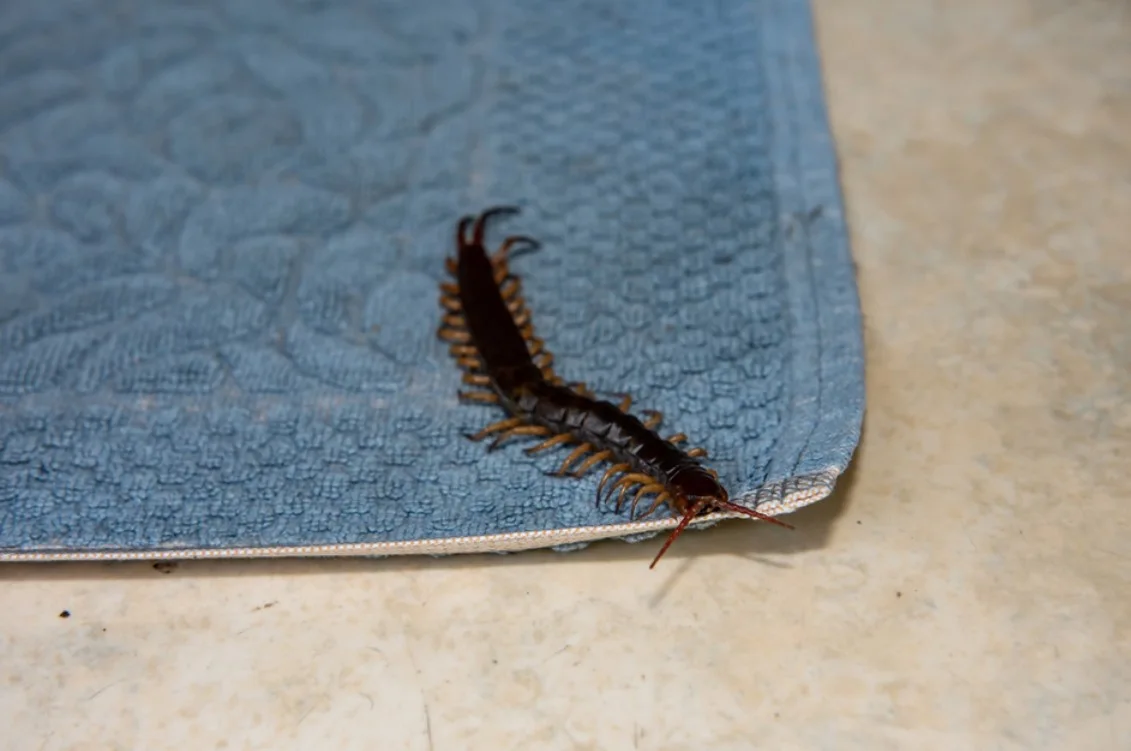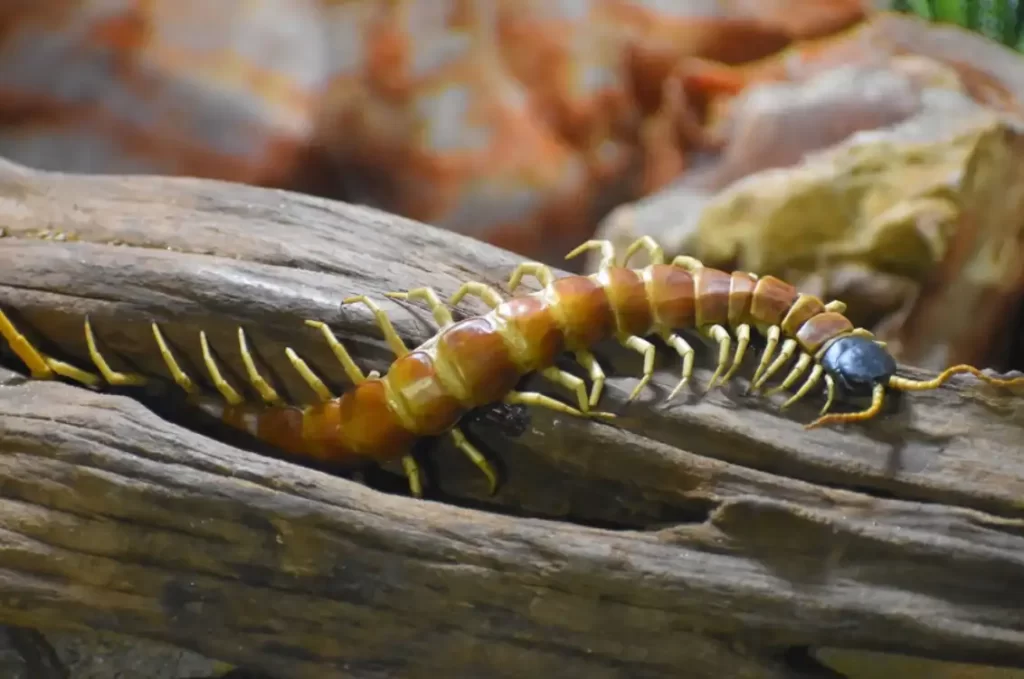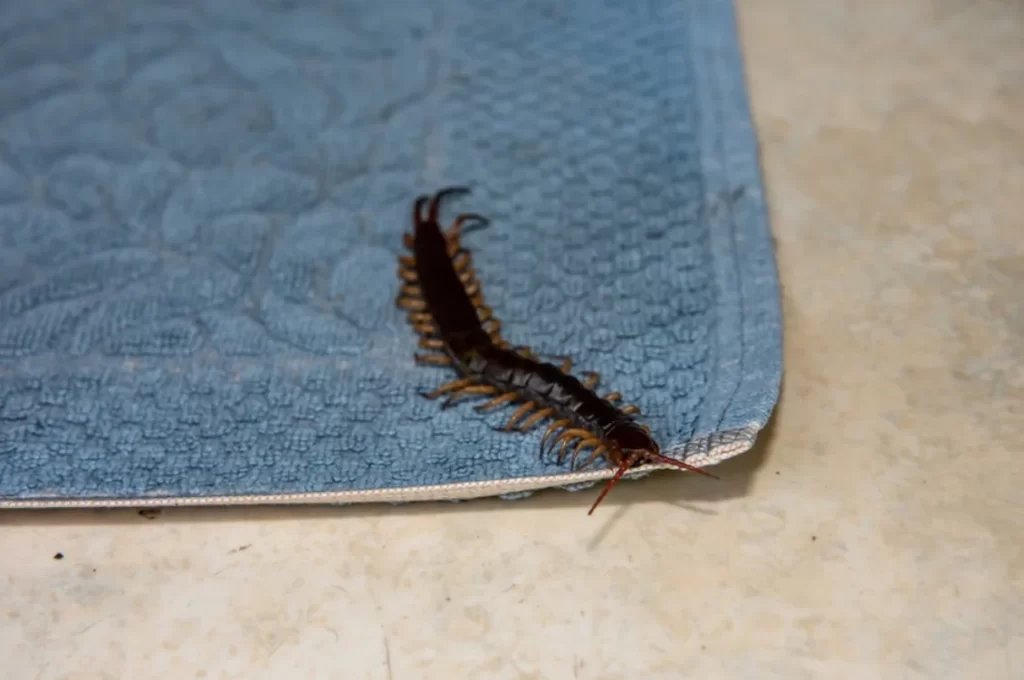How to keep centipedes out of your bed? Eliminating these lengthy and unpleasant insects is a difficult process that requires a lot of effort.
In certain regions, these creepy crawlies are a common source of concern for locals. They have 15 sets of skinny legs in a row. A frightening image is created when all the legs start to move at once.
The centipede’s several sets of legs work in tandem to enable it to travel at high speeds and to climb nearly any surface, including walls, furniture, and beds.
Predatory insects like centipedes invade your house since their natural habitat is wet and gloomy regions with plenty of moisture.
Let’s start with a definition of centipedes and an examination of whether or not their bite may be fatal before moving on to discussing effective methods of extermination.
Page Contents
What are centipedes?
Centipedes, which belong to the phylum Arthropoda, are metameric, elongate, and have many legs. Each section of their body contains a pair of legs.
Centipedes’ many sets of legs make them effective hunters and prey.
The first two legs of a centipede have been adapted into poisonous stings that are used to stab victims. They inject poison into the air with these legs and utilize them to hunt silverfish and termites.
Centipedes’ legs serve a crucial function in transporting several insects at once. They actively search for food and use their venom to kill their victim instead of setting traps.
When they multiply inside your home, it’s a red flag that additional pests may be lurking nearby. Centipedes are most likely in your home since they feed on little insects.
Are centipedes insects?
Centipedes are a great confusion to classify into a single category because they share several identical characteristics with insects and also show differences from them. Somehow, they are classified as insects but belong to a different group called the Chilopoda.
One of the major differences is the number of segments on their body which they have in the range of 15 to 177, depending upon the body length and the type of species.
In contrast, insects’ bodies are into three segments, the head, abdomen, and thorax. Also, insects have maximum legs.
Another difference is a pair of wings insects have on their body while centipedes do not.
The third difference is centipedes use their venom for hunting and killing their prey, while insects, on the other hand, like honey bees and ants, use their venom for their defense.
What are centipedes classified as?
Centipedes are classified into the category of arthropods which consist of invertebrate animals such as spiders and crustaceans. These insects have a backboneless body divided into multiple segments, each with one pair of legs.
They are carnivorous and kill small insects and other arthropods to feed themselves.
Several species of centipedes are spread throughout the entire world and live in different environments, such as forests, green lands, and homes where moisture is abundant.
They are nocturnal creatures who stay in hiding during the day and come out for a hunt at night.
Because of their segmented body appearance, they are often mistaken for millipedes, and the major difference is the number of pairs of legs per body segment.
Centipedes have one pair of legs, and millipedes have two pairs at each body segment.
How big do centipedes get?
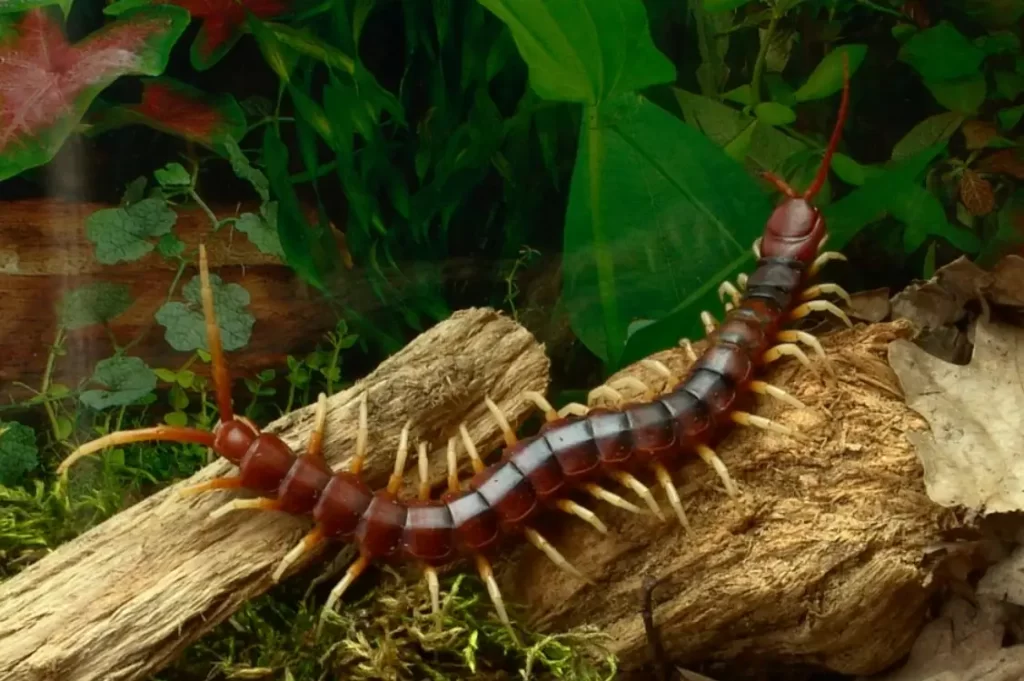
The centipede body size often varies from species to species. Sizes range from millimeters to well over a meter for these creatures.
Scolopendra gigantea, the largest size centipede, may reach a length of 30 centimeters. House centipedes like Scutigera coleoptrata, on the other hand, reach a maximum length of only a few millimeters at most.
Their body parts and legs can be anywhere from 15 to 177 different sizes.
How many legs does a centipede have?
Centipedes are notoriously famous for their several pairs of legs, making them scary when moving. The number of legs depends upon the centipede’s body size, ranging from 15 to 117 pairs of legs.
It also depends upon the number of segments of the centipedes’ body. Their segmented body has one pair of legs at each segment of the body.
In short, the longer the body of the centipede, the number of segments will be more and, therefore, greater the number of legs it has.
Unfortunately, their multiple legs do not make them faster and better climber compared to other insects with fewer legs.
Where do centipedes come from?
Different species of centipedes have developed their body according to the different types of environments around the globe. Typically, they are found in areas where moisture is abundant, and the sunlight is less, such as thick forests, grasslands, and areas under the rocks.
The origin of centipedes can be found 443 to 416 million years back in the Silurian period when they were considered the only invertebrates on the planet.
They have developed shape and characteristics with time and become successful predators.
Their species are spread over all seven continents except Antarctica and can be found in several habitats. Even a few species can live in aquatic conditions like rivers and streams.
What causes centipedes to come around?
Centipedes like damp places like your basement because they may find food and shelter there. Due to the evaporation of their bodily fluids under dry conditions, they require a humid habitat.
One such factor is the convenience of having food supplies at home. These predatory insects devour other insects of similar size for sustenance.
As a result, having even a few spiders or cockroaches in your house might invite even more of the little critters inside.
You can prevent centipedes from entering your home by following a few simple steps. The first is to maintain regular cleaning routines at home and to eliminate waste; doing so will help to eliminate the presence of insects of a smaller size.
You may prevent centipedes from entering your home by thoroughly inspecting the structure and immediately filling any cracks you find.
To further prevent fresh centipedes from entering your home, you may use a dehumidifier to remove excess moisture.
Are centipedes poisonous?
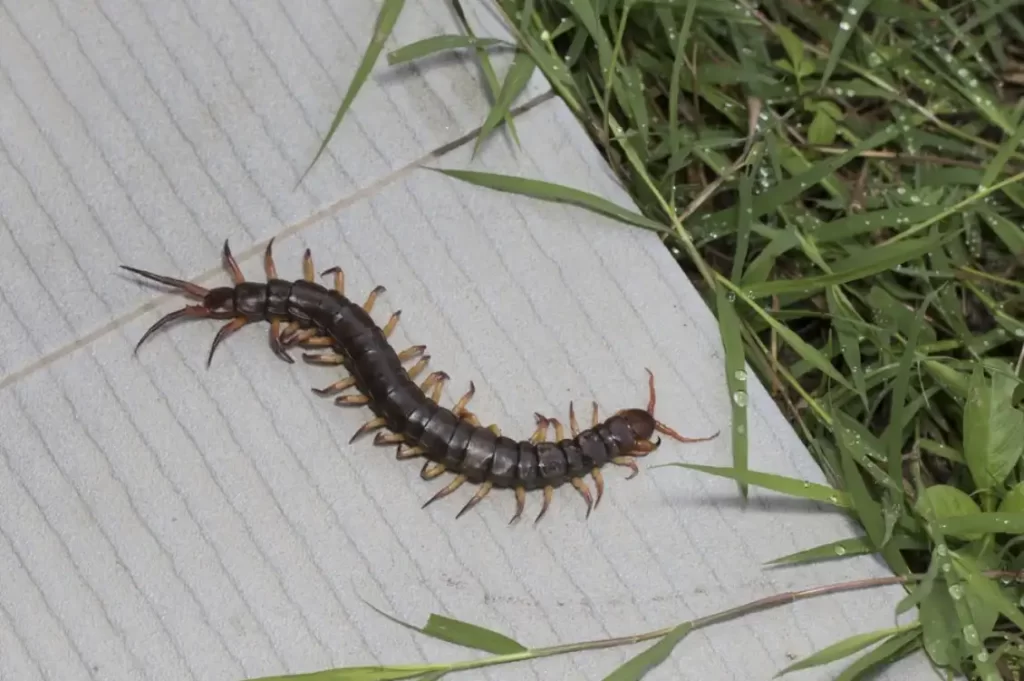
Centipedes are not poisonous, but they are venomous, and both types feel harmful but are different. Poisonous organisms produce toxins, which they inject into the body by biting the skin. Poison of some organisms like snakes is harmful and can be life-threatening when ingested.
On the other hand, venomous organisms have developed glands in which they produce toxins and inject them into the body of prey by their stings to subdue them.
The centipedes have modified the front pair of legs into venomous stings, and their venomous glands are in between them.
The venom of centipedes assists them in killing their prey and eating them to stay alive, but this venom cannot save them from their predators.
Luckily, the venom of most centipede species is not strong enough to harm humans.
However, few species produce strong venom, which can mildly affect humans and cause swelling.
But the intensity of venom is not strong enough to spread in the entire body, and it has a very limited effect and feels only around the area of the bite.
Moreover, they do not attack humans unless provoked by any activity. If you see them around you, do not bother them, and accidentally if they bite you, instantly wash the bite wound with hand cleaner.
How many centipedes are in the world?
More than 8,000 species of centipedes have been found by scientists, and many more need to be discovered.
Due to environmental circumstances, these species are found on every continent with the exception of Antarctica.
Therefore, it is difficult to determine the actual number of centipedes in the planet. Intriguingly, centipedes belong to the oldest group of Chilopoda, which is about 400 million years old.
As predators, scavengers, and decomposers, these crawling organisms perform a vital part in the ecology.
Over the course of millions of years, they have adapted to a variety of environments, including soil, water, leaves, and wood.
After years of investigation, scientists have just a limited understanding of their function in preserving our ecology. Numerous studies are being conducted on these terrifying beasts.
What are centipedes good for?
Centipedes are very good for our ecosystem, and they play three roles in balancing the cycle of our ecosystem.
Centipedes play a major role as a predator in the ecosystem. They hunt different species of small insects like ants, flies, and mites to feed themselves and stay alive.
In this way, they control these insects’ population and maintain a balanced number of insects according to the ecosystem’s capacity.
Another role centipedes play in maintaining the balance of the ecosystem is as a decomposer. When they crawl on the land and leaf litter, they break down and recycle the nutrients back into the ecosystem.
Alongside predators, they are also prey and food source for different organisms. They have developed two venomous stings on their head for defense, but sometimes a bigger predator kills them to feed.
Does light keep centipedes away?
If you think of hurting centipedes with torch light or with any other source of light, then you can hurt them but to a very limited extent.
Centipedes do not come out in the daytime and stay in hiding because of dryness outside. They are nocturnal organisms, so they come out only during nighttime.
They are attracted to dark and damp areas because they avoid the presence of light. But it is not sufficient to stop them.
Instead, various other methods are quite effective in stopping centipedes from coming to your home.
You can use chemicals to eradicate centipedes. Moreover, you can bring their predators into your home and use traps to kill these creatures.
How to keep centipedes out of your room and bathroom?
Although they are not harmful to humans, their presence can be disturbing, and no one wants to allow centipedes to keep roaming around them.
If you want to keep them away from your room and bathroom, follow the below-mentioned tips:
Search all the cracks and open holes in your home where centipedes can hide or use to enter your home and completely fill them.
Keep your lawn well managed and remove all the debris or stone under which centipedes can hide.
Moist and dark conditions are the favorite living conditions for centipedes. So, keep your home fry and ventilated to reduce the chances of their presence.
Regularly clean your house and make sure there are no other species of insects that can be a source of food for centipedes and can attract them.
In the worst situations of centipedes attack, use chemical pesticides to kill them effectively.
If you carefully follow these techniques, you can keep centipedes away from your room and bathroom.
Natural centipede repellent
Along with several practical techniques, you can use some natural materials to repel centipedes. Let’s discuss them one by one.
First on the list is peppermint oil which can help you to keep them away from you. This oil has a strong smell which is quite pleasant for humans but for centipedes; it works as a repellent.
The best way to use peppermint oil is to mix a few drops in water and shower in and outside your home.
Another way to use peppermint oil is to soak the cotton balls with this oil and place them in different places where these creatures can hide.
The second natural repellent is diatomaceous earth, the powder form of decomposed algae. This repellent attacks the exoskeletons of these insects and dries them out.
Spread Diatomaceous earth around your house, in front of doors and windows, and in cracks where they are hiding.
The next amazing repellent is Cedarwood oil which can assist you in keeping centipedes away from your house perimeter. The strong woodsy smell of Cedarwood oil feels very unpleasant to many insects, including centipedes.
Like peppermint oil, dilute a few drops of Cedarwood oil with water and spray around the places where they can hide or use to come into your home.
You can also bring their natural predators, like lizards and birds, to eliminate centipedes from your home.
How long do centipedes stay in one place?
Like all living organisms, centipedes are constantly searching for food and shelter as long as they get enough food to survive in a safe and secure place and will not leave that place until you kick them out.
So, it is impossible to answer the question of how long centipedes stay in one place. The natural habitat of these insects is dark and damp places, and their source of food at these places is spiders and silverfish.
Their liveable shelter is shady areas of gardens in your home. Centipedes can stay in one place until they get enough survival food.
They can also stay in your basement because of moist conditions and the presence of small insects as a food source.
Once the food source ends and the environment changes, they move from that place and search for a new shelter and food source.
Signs of house centipede infestation
There are many alarming signs which warn you about the presence of centipedes. A few of them are discussed below:
Sliding Traces of Centipedes
When centipedes move, they leave sliding races of their movement behind them. If you see these sliding traces in your home, it clearly signifies centipedes’ presence. Instantly search for 1-1.5 inches long, yellowish-gray or brownish-gray color insect with long, slender legs. If you find any in your home, they are likely a high chance of centipede infestation.
Damage to plants
Check the stems and leaves of plants in your house garden. If you observe any damage or holes in the leaves, you should collect this signal and suspect the presence of centipedes because they can chew plant leaves. They also lay their eggs on plant stems and leaves.
Odor
Centipedes secrete their pheromone as a trap to attract their prey mates. The odor of this pheromone is musky, which they leave in the areas where they are hiding. If you smell this odor in specific areas of your home, it signifies their presence at that place.
Can centipedes climb beds?
Centipedes have several pairs of legs which support them to climb over various places and things, including your bed.
With their backboneless flattened body, they can easily crawl and climb your bed. But they can rarely be found in dry places like your bed; otherwise, they are often found in damp and dark areas.
If you suspect the presence of centipedes in your home or room, it is possible that they can reach your bedding. They usually come out during nighttime when you are sleeping. But they are not aggressive insects and do not attack humans unless you provoke them.
To present them reaching your bed, follow all the techniques mentioned above. Take instant action to eradicate their infestation and adopt daily cleaning practices to keep your living area safe from centipedes.
Final Verdict
Basements, gardens, and gloomy parts of lawns are frequent places to find centipedes. They have a golden or brownish flattened body and a thin build. Sizes range from a few millimeters to 30 centimeters; they have a segmented body with one set of legs per segment.
Though they may be either prey or predator, they pose no threat to humans. They are essential to maintaining a stable ecology. Take immediate action if you see any signs of centipedes in your house.
- Where Can I Purchase Bed Bug Bombs? - January 30, 2023
- Where Can I Buy Something to Kill Bed Bugs? - January 30, 2023
- Where Can I Buy Bed Bug Spray? - January 30, 2023
